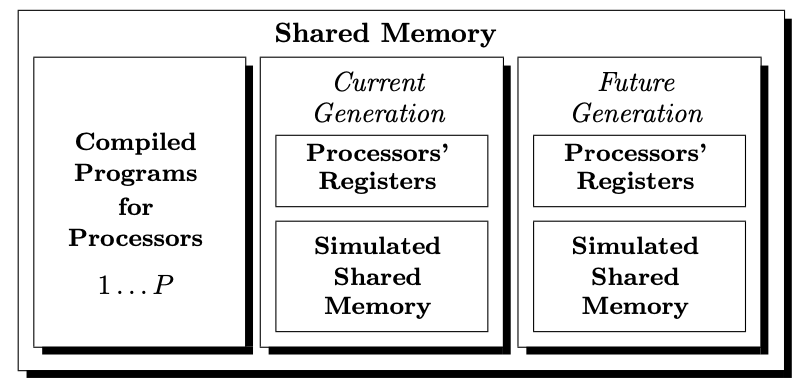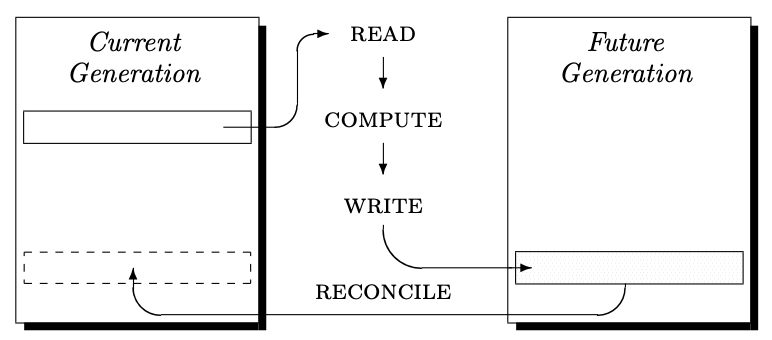Simulations
- goal: simulate fault-free PRAMs on fault-prone PRAMs
- preserve the efficiency of the original algorithm
- processors are subject to fail-stop failures
- Following two cases have equal complexity:
- execution of a single
- solving
- execution of a single
Fault tolerant PRAM
(definition)
- given arbitrary failure pattern
- fault-free PRAM
- PRAM
PRAM is fault-tolerant when any sequence of instructions of
Simulation efficiencies
Simulation is
- optimal for
- robust for
- polynomial for
Example: GPA simulation
- This simple example uses general parallel assignment (GPA) problem:
- inputs:
- array
- function
- array
- in parallel, compute for each value in y:
- assume cost of
- inputs:
Failure-free solution
1 2 3 4 5 | |
Fault-tolerant version
Assume surviving processors can be reassigned to unfinished tasks.
1. convert assignment to idempotent form
solution must accommodate multiple attempts to write by different processors at different times.
Assignments are made idempotent by introducing two generations of array
1 2 3 4 5 6 7 | |
- values of the first generation array are used as input
- computed values are stored in the second generation array
- the binary version number is incremented after all assignments
2. Modify robust write-all algorithm
Assume
- before each
x[e] = 1for some variablee, insert:y[v+1][e] = f(e, y[v][1...N]) - insert statement to increment
vbefore HALT statement of each processor's code
to obtain
- correctness of
- assignments to
- when
=> complexity of solving GPA is equal to complexity of solving write-all.
Implications:
- use any write-all and appropriate function
- to simulate arbitrary parallel step: use iterative parameterized approach:
- targets of assignment correspond to memory locations written by simulated processors
PRAM interpreter
- Goal: construct fault-tolerant PRAM interpreter
- This same methodology can be used to
- simulate parallel algorithms or
- transform parallel algorithms to robust algorithms
- interpreter can execute any standard PRAM models (CRCW, CREW... etc.)
- if we are able to simulate PRAM interpreter in another parallel/distributed model, then any PRAM program also becomes program in that model.
- If we understand: 1. efficiency of PRAM program and 2. complexity of simulating PRAM interpreter in another model → able to evaluate efficiency of the program in the context of another model
Pseudo code of the PRAM interpreter (failure free)
1 2 3 4 5 6 7 8 9 10 11 12 13 14 15 16 17 18 19 20 | |
PRAM interpreter definition
- has
- processors have unique PIDs from 1 to
- each processor has:
- instruction buffer (IB)
- internal registers
- instruction counter (IC)
- a read register (RR)
- write register (WR)
- shared array
PROG[1..P,1..size]stores instructions of a compiled PRAM program (size does not depend on P)- program per processor is
PROG[i,1..size]with on instruction per array element
- program per processor is
- uses shared memory cells
- first
- cells and registers can store
- first
- Instruction set
- read instruction into IB
- read into RR contents of
- assign to r result og computation C(r)
- write contents of WR to shared memory
- update instruction counter; if IC=0 then HALT.
Regarding memory,
- The instructions are stored in memory and address of next instruction in IC.
- private memory is typically larger than in a uniprocessor to avoid shared memory access/maximize local computation
- up to
- if private memory needs for an algorithm exceed the maximum, shared memory can be allocated to each processor
- up to
Shared memory structure for simulations

Fault-tolerant version
- after this transformation can execute fault-free PRAM programs in presence of failures
- the fault free program is the input to the interpreter
Transformation steps
- shared memory management:
- compiled PRAM program is stored in shared memory
- remaining shared memory is used to simulate shared memory of PRAM, containing two generations of memory (current and future)
- private registers of simulated processors are stored in each generation of simulated shared memory
- private registers
- private registers
- current memory is used for reads, future memory for writes
- all memory references are made using generation subscript 0 or 1
- asymptotic memory requirement is
Memory that can be read by processors is not changed until it is safe to do so → results in idempotent PRAM instructions enabling (possibly) multiple executions.
Simulation proceeds for each parallel step until simulated PRAM halts as follows:
- each simulated PRAM step is executed (by performing read/compute/write as necessary)
- current and future memories are reconciled by copying changed cells and new register values from future to current (to produce new current memory)
- simulated instruction counter has value 0 to indicate halting
Processing within simulation step

Pseudocode
for an interpreter using 2 generations of memory
1 2 3 4 5 6 7 8 9 10 11 12 13 14 15 16 17 18 19 20 21 22 23 24 25 26 27 | |
- Write-all algorithm is used to execute each 4 actions in the work phase → assures that actions of given phase are performed before actions of the next phase are attempted
- Typical write-all uses
- do not need to be
- do not need to be
- Memory needs to be cleared when running write-all consecutively
- utilize two workspaces of size
- use one workspace and clear the other; at the same time, during simulation
- has no asymptotic impact on memory usage or efficiency of robust algorithms
- utilize two workspaces of size
- Lastly check for termination: processors examine simulated ICs and write
halt = falseis
Pseudocode for fault-tolerant PRAM interpreter
1 2 3 4 5 6 7 8 9 10 11 12 13 14 15 16 17 18 19 20 | |
Analysis
- let
- complexity of applying single PRAM step in bounded by:
- complexity of solving write-all in steps
a,c, ande - complexity of robustly writing and copying
bandd
- complexity of solving write-all in steps
- to copy
- total cost of one PRAM step is:
Simulation Cost Theorem
Cost of simulating a single parallel step of
fault free processors, each using private registers, on fail-stop processors in failure model is where is the work complexity of solving the write-all problem of size in using processors.
When PRAM dies not need additional private memory cost of PRAM step simulation is
General Simulations
Simulations for different failure models.
Initial failures
More simple simulation:
- can bypass most steps used by fault-tolerant PRAM interpreter
- use algorithm E to simulate on fail-stop PRAMs subject to initial failures
Algorithm E uses enumeration phase E1 to determine active processors. The remaining simulation contains a loop in which:
- to perform work of
- each processor of
Assume processors halt in synchrony, then:
| Enumeration overhead (additive) | |
|---|---|
| time overhead | |
| work overhead |
Any
-processor, -parallel-time EREW PRAM algorithm can be robustly simulated on a fail-stop EREW PRAM that is subject to static initial processor and initial memory faults. The work of the simulation is , where is the number of live processors.
Simulation subject to initial failures is optimal when
Synchronous restarts
Use fault-tolerant PRAM interpreter to show robust and optimal simulations are possible → also applies when restarts allowed in synchrony at specific points e.g. next PRAM step.
Any
-processor EREW, CREW, or Common CRCW PRAM algorithm that uses arbitrary shared memory and polylogarithmic in the input size private memories can be robustly simulated on a fail-stop -processor Common or Arbitrary CRCW PRAM when . Any
-processor EREW, CREW, or Common CRCW PRAM algorithm can be optimally simulated (with constant overhead) on a fail-stop -processor CRCW PRAM, when .
Detectable restarts
Any
Each
| Work, Overhead Ratio | |
|---|---|
| work |
|
| overhead ratio |
- EREW, CREW, and Common CRCW PRAM algorithms are simulated on fail-stop Common CRCW PRAMS
- Arbitrary CRCW PRAMS are simulated on fail-stop CRCW PRAMS of the same type
From this follows that:
- when
- when
Overhead ratio
Undetectable restarts + asynchrony
-
this model is essentially identical to PRAM model with asynchronous processor behavior and atomic memory read/write access → view disparity in processor speeds as failures.
-
in the presence of arbitrary asynchrony or when the restarts are undetectable, deterministic simulations become difficult due to the possibility of processors that are delayed by failures writing stale values to shared memory.
-
Simulation approaches using information dispersal techniques and randomization have been pursued for asynchronous settings.
Any
-processor, -time, -memory PRAM algorithm can be (deterministically) simulated on a fail-stop -processor CRCW PRAM ( ) with undetectable restarts, and using shared memory . Each -processor PRAM step is executed in the presence of any pattern of failures and undetected restarts with for .